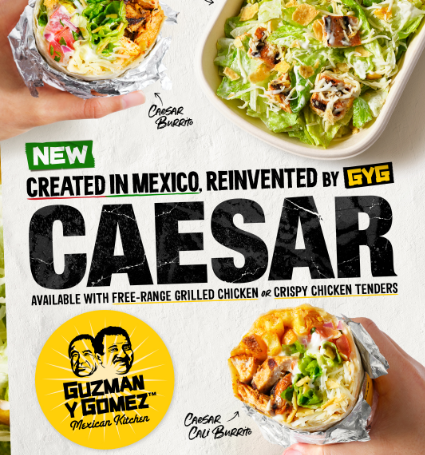
For decades, food lovers have argued over what makes a proper caesar salad.
Now, Guzman y Gomez has reignited that debate by launching a range that leaves out ingredients many Australians consider essential.
But in doing so, they may have edged closer to the salad’s original Mexican roots than critics realise.
The Mexican-inspired fast food chain rolled out their caesar salad, burrito and Cali burrito nationally on 30 September, following trials at select locations.
Their $14.50 caesar salad quickly drew attention for what it left out—namely bacon, eggs, and anchovies.
'A fun fact not many people know is that the caesar salad originated in Mexico, and didn't contain bacon or an egg.'
The controversy traces back 101 years to 4 July 1924, when Italian immigrant Caesar Cardini created the first caesar salad at his Tijuana restaurant.
Cardini had opened the venue to serve food and liquor to Americans trying to circumvent Prohibition.
According to his daughter Rosa, Cardini invented the salad during a Fourth of July rush when kitchen supplies ran low.
Using just seven ingredients—whole romaine lettuce leaves, raw egg yolk, Italian olive oil, grated Parmesan cheese, Worcestershire sauce, lime juice, and a toasted bread slice—he created what would become one of the world’s most famous salads.
The tableside preparation was more than showmanship—it was a necessity turned spectacle to distract hungry American tourists from the improvised nature of their meal.
Original 1924 Caesar vs Modern Caesar
Original ingredients: Whole romaine leaves, raw egg yolk, olive oil, Parmesan, Worcestershire sauce, lime juice, toasted bread slice
Modern additions that came later: Bacon, anchovies, garlic, croutons, lemon juice (instead of lime), Dijon mustard
What GYG includes: Grilled chicken, cos lettuce, corn chips (as croutons), Jack cheese, caesar dressing
The original caesar salad had no croutons and no anchovies, although later recipes either mashed anchovies into the dressing or relied on Worcestershire sauce, which contains anchovies.
Bacon and egg were introduced later as the dish spread from Tijuana across America.
Hollywood stars like Clark Gable and Jean Harlow flocked to Tijuana to try the salad, and in the 1960s, legendary broadcaster Julia Child called it 'a sensation of a salad from coast to coast'.
This celebrity endorsement helped spread numerous variations, with some restaurants later adding ingredients ranging from maple syrup and asparagus to smoked trout and tandoori prawns.
Critics’ reactions to GYG’s historically inspired approach were mixed.
One dismissed the caesar salad entirely, giving it three out of 10 and questioning whether it could 'really call it a caesar salad with no egg, bacon or parmesan cheese'.
Others embraced the fresh take.
Food reviewer Nectro Vlangos praised the creamy dressing with 'a little twang to it' and loved the corn chips for crunch, predicting 'this salad will go off over summer'.
Social media user Chloe was even more enthusiastic, comparing GYG's caesar launch to watching 'two of your favourite celebrities have a baby' and declaring it one of the best caesar salads she had ever tasted.
The caesar burrito was more universally popular.
Even the critical reviewer admitted that while it was 'neither a burrito or a caesar salad,' it was 'awesome' and he'd 'eat that for lunch.'
Tyler Carroll, who spent $6,500 at GYG last financial year, said the dressing-heavy creation gave him 'Mexican snack wrap vibes' and was 'f****** really good.'
For Australian diners, the $14.50 price point sparked debate about value.
Traditional caesars often include protein-rich ingredients like bacon and eggs, leaving some questioning the worth of GYG’s stripped-back version.
GYG addressed the protein concern by adding grilled chicken with their signature Guerrero marinade, staying true to their Mexican-inspired brand.
The corn chips replacing traditional croutons also added a distinctive texture, setting the salad apart from standard offerings.
GYG founder and co-CEO Steven Marks called it the 'biggest product launch' of the year, noting 'Aussies love a caesar, and we have genuinely reinvented it.'
The company’s confidence suggested they believed historical authenticity and Mexican heritage would resonate with Australian consumers, even if some traditional elements were missing.
This debate reflects broader questions about food authenticity in a globalised dining landscape.
As a food writer noted in The Washington Post, 'After a century, the Caesar salad, which asserted Cardini's heritage in a foreign land, has become a universal language.'
GYG’s approach suggested that returning to historical roots could be as valid an innovation as adding new ingredients.
Whether Australian diners would embrace this philosophy—or continue expecting bacon and eggs with their caesar—remained uncertain.
The success of GYG’s caesar range may ultimately depend not on historical accuracy, but on taste, value, and consumers’ willingness to appreciate the original vision of an Italian restaurateur who created culinary magic from kitchen scraps on a busy Fourth of July in 1924.
What This Means For You
The GYG caesar salad omits traditional modern ingredients like bacon, egg, and anchovies, bringing it closer to the original 1924 recipe.
The salad was first created in Tijuana during Prohibition, using just seven simple ingredients, which highlights its historic roots.
Critics and diners have had mixed reactions—some praising the innovation, while others question whether it still qualifies as a true caesar salad or represents good value for money.
GYG has balanced historical authenticity with its brand identity by including grilled chicken and corn chips, offering both taste and texture while telling a story through the dish.
For diners, this means there’s an opportunity to try something different that honours the salad’s origins while still enjoying a satisfying, protein-rich meal.
It invites you to reflect on whether sticking to tradition or embracing modern adaptations matters more when choosing what goes on your plate.
If you’ve enjoyed exploring how Guzman y Gomez is reimagining the Caesar salad, there’s another story that dives into the charm of classic dining experiences.
This piece highlights a restaurant that has maintained its old-school atmosphere and menu, showing how tradition can coexist with modern tastes.
It’s a fascinating look at how food, nostalgia, and authenticity come together in a place that has stood the test of time.
Read more: Where old-school dining experience refuses to fade away: 'I used to come here'
Guzman y Gomez’s new Caesar menu divides food critics — Reports on GYG’s launch of a Caesar salad range in Australia, highlighting the omission of traditional ingredients like bacon, egg, and anchovies.
https://www.news.com.au/lifestyle/f...s/news-story/3412fd1d6103f05e3f8dafb75fa01e78
Caesar salad — Wikipedia — Provides the historical origin of the Caesar salad, created on 4 July 1924 by Caesar Cardini in Tijuana, Mexico.
https://en.wikipedia.org/wiki/Caesar_salad
Caesar salad turns 100: It was born July 4, 1924 in Tijuana : NPR — Discusses the 100-year history of the Caesar salad and its creation in Tijuana, Mexico, during Prohibition.
https://www.npr.org/2024/07/03/nx-s1-4993520/caesar-salad-100-years
No croutons, no anchovies, no bacon: the 100-year-old Mexican origins of the Caesar salad / 2024 / Stories / Hippocampus / The University of Newcastle, Australia — Explains Cardini’s original recipe, its historical context, and how modern additions like bacon and anchovies came later.
https://www.newcastle.edu.au/hippoc...-year-old-mexican-origins-of-the-caesar-salad
The story behind Caesar salad | National Geographic — Covers celebrity visits to Tijuana to try the original Caesar salad and the spread of the dish internationally.
https://www.nationalgeographic.com/travel/article/story-behind-caesar-salad
The Caesar salad, born in Mexico and celebrated worldwide, turns 100—The Washington Post — Notes the global influence of the Caesar salad and its recognition as a culinary icon, while preserving Cardini’s heritage.
https://www.washingtonpost.com/food/2024/08/05/caesar-salad-birthday-history-mexico-cardini/
Who knew? The original Caesar salad recipe made its debut on the Fourth of July in Tijuana, Mexico. — Details the seven original ingredients used by Cardini to create the Caesar salad.
https://www.uchealth.org/today/the-origin-of-caesar-salad-plus-original-recipe/
Should a caesar salad stick to its Mexican roots, or have the modern additions become essential for today’s diners?







